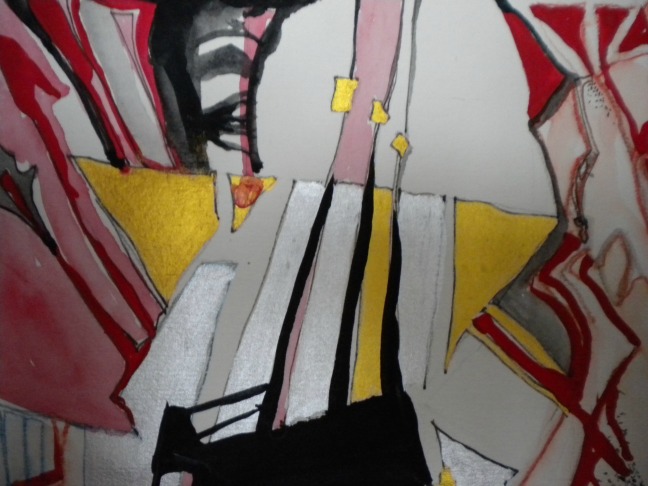Gouache Painting. Definition. Paint Techniques. Gouache vs Watercolor.
Most people are not quite sure what exactly the term gouache painting means. Gouache is a technique and a product at the same time!
The name gouache (pronounced "gwash") is French and derives from the Italian aguazzo (=mud), both referring to an opaque water color. However, this type of color is distinctively different from water color: it consists of pigment and a binding agent (usually Arabic gum), as water color does, but (unlike water color) the main difference is the following. The particles are larger, the ratio of pigment to water is much larger and, in addition, chalk is also present: the result is the "opaque" character of this painting medium.
The technique appeared first in Medieval times, in the decorative embellishments of illuminated manuscripts. The German artist Albrecht Dürer (16th Century) used this medium in his nature paintings. During the 17th century, gouache was introduced to England. Topographical artists started using this method from around 1740.
Opaque techniques flourished during Impressionism and Post-Impressionism: the artists were fascinated by the medium and its brilliance of color, and started using it extensively. After the first world war, and around 1930, the medium improved significantly and the result was the "Designers Opaque Water Colour."
Who Uses Gouache?
Fine artists: they either use it in together with water color or by itself. The medium is excellent for abstract work, as it gives colors an outstanding brilliance and solidity. But, its main characteristic is the fact that it carries all of the benefits of watercolor, oil paint, and acrylic!
Designers: the name, "Designers’ Gouache," was given because of the easiness of its use as well as its brilliance. The color is obviously very popular among designers as it dries very fast, leaves a matte finish, and work can be done with extreme accuracy.
Calligraphers: this medium is highly preferred in calligraphy, due of its opacity, permanence of results, but also because of its superb "flow" during work.
Airbrush artists: its unique covering power, and its opaqueness, make this color popular in airbrushing.
Marblers: gouache is a preferred choice of professional marblers because of its high pigmentation and its gum arabic base.
Gouache Painting: An Example (detail)
In the above painting, you can watch the amazing power of the gouache medium: the back ground has been left blank (white paper). Against this white back ground, very few colors are used: red, black, and two 'metallic' colors (silver and gold). The lightness or darkness of the colors is achieved ONLY through the amount of water mixed (more or less, accordingly). The metallic colors achieved this brightness through repeated layers, and by using minimal amounts of water.
Special tips: you have to wash the brush very well after EACH application of 'gradation' of color! For the metallic colors: do not use more than three layers, as the surface may 'crack.'
Gouache vs Watercolor
Gouache creates flat color areas without any flaws: this is rather difficult to achieve with watercolors.
Unlike watercolor, the paint covers all layers below it. This makes the painting process easier, as it feels more direct. For example: when painting flowers with watercolors, a darker background must be carefully painted around the flower. However, with gouache, this is not the case: one can paint light colors on top of darker ones! This technique is closer to that of oil painting. And this capability makes this medium quite unique.
Further characteristics of gouache paint: only a very small amount of paint is needed to create a thick paint layer! As commented above, the paint can be applied on both a white or colored background, without affecting the intended color density.
The lightening of colors is created by adding white pigment, and not by adding more water (as in the 'water-dilution' watercolor technique).
Gouache paint is not absorbed into the paper, unlike watercolor. This means that some textural effects are possible. However, if too much paint is used, there is always the danger of the "cracking" of the surface.
Due to the above described characteristics, the medium is preferred by designers. It is also a favorite among architects and commercial artists, as this medium can be photographed and reproduced very effectively.
Fine artists must be very careful in their choice of paints: not all brands include the pigment information on their labels. Some of the colors may not last!
Gouache Painting: My Works
By clicking on the following link, you will be transferred to the Sxisma Art Gallery where most of my art work is on display. Though I generally use gouache as my preferred medium, the link refers to a distinct selection of six of these paintings. If you take the time to look closely, you might easily distinguish the several ways I use this paint medium. A comment: I only use one brush! It's medium thick and yet, I find that I can use it for both very fine lines as well as for full surfaces. The trick here is the way you handle the...brush!
More Gouache Links
Recent Articles
-
Art Licensing Agents: List of 40+ USA and UK and European Agencies
Apr 07, 24 12:34 PM
Art Licensing Agents. What They Are and Why Do Artists Need Them. List of Over 60 USA and UK Art Licensing Agencies. -
Social Links: Social media.
Mar 06, 24 08:24 AM
Social Links: Social Media. Twitter, LinkedIn, Youtube, Soundcloud, Pinterest. -
Projections Split. A Composition for large orchestra.
Oct 26, 23 08:49 PM
Projections Split. A Composition for Large Orchestra.







